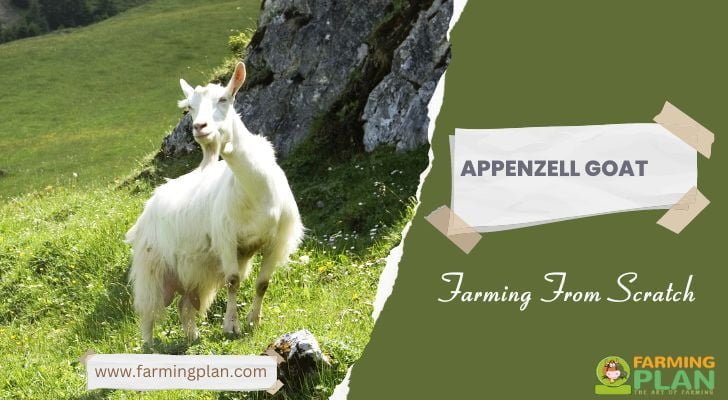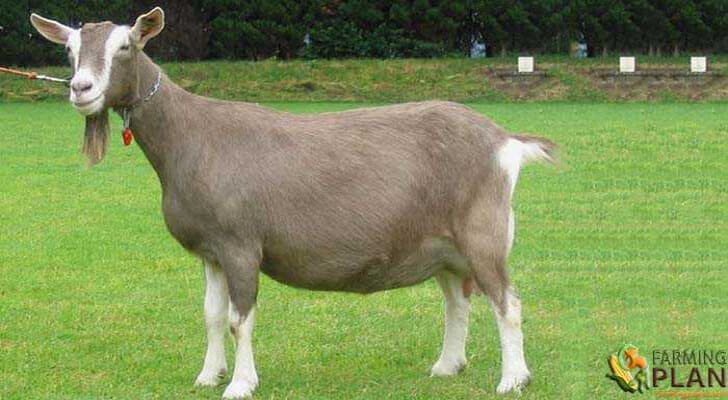Are you looking for a remote, yet sustainable way to make a living? If so, then the Appenzell Goat—a hardy breed of domestic goats originally from Switzerland—could be your solution. Their long-standing roots provide us with an insight into farming history unlike any other and set them apart in many ways. They are docile animals that thrive even in difficult conditions combined with their ability to produce milk full of energy and nutrients making the Appenzell Goat the perfect choice for anyone wanting to raise farm animals that could provide valuable products with minimal inputs or resources. In this blog post, we will explore why they’re such great goat breeders, how they can help make sustainable farming possible, and some tips on setting up your own successful Appenzell herd!

History & Origin
The Appenzell Goat is a rare and endangered breed of Swiss goat, with an impressive history that dates back centuries. Originating in the mountainous regions of the Appenzell region in northern Switzerland, they were first bred by farmers who used their fleece for fabric production. The goats were traditionally kept as dairy animals and even today, their milk is renowned for its high-fat content, perfect for making cheese, yoghurt, and butter. They also have great herding capabilities due to their alertness, agility, and intelligence. Renowned for their unique white color, long ears, and sturdy build, these ancient animals have managed to survive difficult circumstances throughout the years to still grace us with their presence today.
Characteristics
The Appenzell goat, also known as the Chèvre d’Appenzell or Appenzellerziege, is a rare and endangered breed of white domestic goat found in Switzerland. This breed has an average height ranging between 75 cm and 85 cm at the withers and typically weighs between 44 kg and 54 kg. It has an erect form with proportionately long legs, a deep chest, and an alert appearance. Its smooth coat is entirely white but may display small patches of ecru or light brown on the head. This breed is especially known for its hardiness, making it highly ideal for harsh climates. With its strong resistance to diseases, this Swiss marvel continues to remain an important part of Swiss livestock production.
Feed
Taking good care of Appenzell Goats is essential for raising healthy, sustainable animals. An important part of animal husbandry is providing proper feed for the goats. Whether grazing in pastures or being provided with hay and fresh vegetables, Appenzell Goats can be fed a variety of nutritious ingredients that will keep them content and healthy. The most important thing is to make sure each goat has access to enough food, which can be monitored by regularly weighing the goats or observing how much they eat when given new feed. So long as they are eaten by their faithful herders, these beautiful Swiss cloven-hooved creatures will live happily ever after!
Usage
The Appenzell goat, also known as the Chèvre d’Appenzell or Appenzellerziege, is an endangered and indigenous breed of white domestic goat from Switzerland. Although historically popular for its milk production and hearty constitution, today this strain is primarily raised for decorative purposes – often used in flowerbeds or zoo decoration. Its body is considered to be naturally resistant to diseases, so medical research may be conducted to develop healthier breeds of livestock. It can still make a great pet for anyone interested in conserving this rare breed!
Special Feature
The one-of-a-kind Appenzell goat is a rare and endangered Swiss breed that has captivated people around the world. Having descendants dating back to 1885, the Appenzell goat prominently stands out for its unique white coloring with black markings. This white coloration has made it a prized possession among many Swiss farmers, as well as across Europe. Thankfully, conservation efforts over the past century have kept this breed from disappearing completely and today, many breeders are taking steps to further develop the characteristics of this special goat. The Appenzell’s hardiness and adaptability to various elements make it even more appealing, allowing it to thrive in different geographical climates and terrains.
The challenges of raising an Appenzell goat
Raising an Appenzell goat, or the Chèvre d’Appenzell, in the modern world can be a daunting challenge. These rare and endangered indigenous goats from Switzerland have special needs that require distinction from other domestic goat breeds. They need plenty of space to graze and room to move around freely to stay healthy and active. Moreover, their diet must contain enough fiber, calcium, minerals, vitamins, and water for them to grow properly. Furthermore, certain expenses like veterinary care must also be taken into account when raising an Appenzell goat. All in all, it is up to the owner to ensure that these needs are met while catering to their individual Goat’s personality so they can become the best version of themselves.
The benefits of raising
Raising an Appenzell goat can be a great benefit for any farmer looking to obtain steady, reliable milk production in harsh conditions. The Appenzell breed is known for its hardiness–capable of withstanding cold temperatures and rough terrain–and overall health. They are good-natured, low maintenance animals that require minimal space and offer advantages such as excellent milk quality and quantity compared to other breeds. With the ability to give up to three times more milk over lactation than other alpine goats, not only does their milk taste great, but it also offers beneficial proteins such as casein alpha s1, that can be sold as supplements or used to make premium cheeses. Not only that, but they are an endangered indigenous species meaning they would thrive in a farm setting while preserving a culture and narrative important to many lives within Switzerland.
Tips for getting started with raising
Raising an Appenzell goat can be a rewarding and enjoyable experience. However, to properly take care of an Appenzell goat, it is essential to understand the fencing needs, feed sources, and nutritional requirements that they need to thrive. The fencing should be solid enough to protect it from predators and other threats. Additionally, when it comes to finding feed sources for your goat, hay is the most important as it fulfills their requirement for a high-fiber diet. Grain can be used for supplemental nutrition, but make sure to avoid certain grains such as corn or barley which can cause bloat if the goat eats too much. Lastly, depending on what type of hay the Appenzell Goat consumes, you may have to supplement certain minerals like copper and zinc. Doing these steps at the start of raising your Appenzell goat will help make their transition into their new home smoother and ensure their health and well-being in your loving care!
Understanding the Appenzell goat’s temperament
The Appenzell goat is so beloved in Switzerland that it has been granted political recognition by the Swiss government! Those who raise these gentle creatures must understand the behavior and temperament of the goat to ensure the best care is provided. Despite its small size, this rare and endangered breed can display aggression if not properly socialized from birth. Fortunately, these goats are good-natured and do not require many steps to be taken for proper management of their aggression. A few basic techniques can help to create a more comfortable environment for everyone – providing enough space for play, allowing adequate exercise, and engaging in positive reinforcement when handling the goats. Doing so will aid in better understanding their social behaviors as well as how to effectively manage any potential instances of aggression.
Breeding your own Appenzell goat
If you are looking to breed your own Appenzell goats, there are many characteristics that you should consider when selecting animals for your breeding stock. Appenzell goats are a unique and rare, white-colored native Swiss breed of domestic goat that is on the endangered species list. Therefore, it is important to select individuals with strong genetic diversity to help preserve their heritage and increase the chances of sustaining a healthy population. The best choice is to select goats with a variety of coat coloration, size, and horn conformation so that desired traits can be passed on to future generations. Those who appreciate the beauty and importance of this special livestock breed should take every precaution when selecting their breeding stock if they want to ensure its continued existence for generations to come!
FAQ
What is an Appenzell goat?
Appenzell goats are a breed of domestic goat originating in the Appenzell region of Switzerland. They have been known for centuries as hardy and reliable animals that could survive in harsh conditions, often living on nothing else than grasses found in the mountains.
What are the characteristics of an Appenzell goat?
Appenzell goats are a breed of goat native to Switzerland, specifically the Appenzell region. They are medium-sized animals and generally light brown, with white muzzles and legs. The females usually weigh between 55 to 80 lbs (25–36 kg) while males usually reach up to 110 lbs (50 kg).
How is the Appenzell goat used?
The Appenzell goat, formally known as the “Appenzeller Sennenhund”, is a rare and ancient breed of goat that is stereotypically found only in the Swiss Alps. Originating from the rocky terrain of Appenzellerland, these goats have been selectively bred for hundreds or even thousands of years to be hardy and adept climbers; allowing them to traverse difficult alpine terrain on their own.
Conclusion
Raising an Appenzell goat can be a rewarding and fulfilling experience. Taking into consideration the special needs of this beautiful, rare breed, understanding its qualities and temperaments, as well as providing proper space, clean water, and nutritious food is imperative for successful husbandry. In addition to being hardy in almost any climate, these goats are also great producers of both meat and milk. With careful planning and research, you can successfully raise your herd of Appenzell goats! While there may be some hurdles to overcome along the way, the result will always be worth it when you see your animals thriving.


